Mechanism of Load Transfer and Deformation Coordination for a Novel Sliding-Type Connection Structure in Bridge Widening: Model Test and Numerical Investigations
Abstract
1. Introduction
2. Segmental Model Test of Sliding-Type Transverse Connection Structure
2.1. Overview of the Test Model
- (1)
- Primary structural framework: The U-shaped steel bars are embedded transversely into the existing bridge flange, and the square steel pipe is subsequently welded onto these bars to form the main structural framework.
- (2)
- Transverse connection: A longitudinal slot is machined into the square steel pipe adjacent to the new bridge flange. The embedded steel bars are pre-installed within the new bridge flange, with stub steel bars welded to their end, and then the embedded steel bars are horizontally inserted into the slot of the square steel pipe. Then, after being rotated 90 degrees about their own axis, the stubs become vertically oriented, preventing the embedded steel bars from being pulled out of the square steel pipe slot. This ensures secure transverse connection between the new and existing bridge flanges without risk of separation.
- (3)
- The first sliding interface: After the embedded steel bars are horizontally inserted into the slot of the square steel pipe, the interface between the embedded steel bars and the square steel pipe is meticulously polished, forming the first longitudinal sliding interface.
- (4)
- The second sliding interface: POM plates and steel plates are placed between the new and existing bridge flanges, with the POM plates positioned against the new flange and the steel plates against the existing flange. This arrangement forms the second longitudinal sliding interface (as indicated by the red lines in Figure 1a).
- (1)
- In-service state of the connection structure. Under the combined effect of partial wheel loads and the differential foundation settlement difference between the new and existing bridges, the focus is on whether the shear stress, tensile stress, deflection, and other structural response indicators of the connection structure comply with the requirements of the design code.
- (2)
- Longitudinal sliding performance. Under the combined effect of partial wheel loads, differential foundation settlement, and longitudinal deformation differences between new and existing bridges, we carefully observe whether the sliding deformation and the amplitude of stress variation at the sliding interface during the sliding process comply with the requirements of the design code to verify the reliability of the sliding interface performance.
2.2. Test Conditions
2.3. Methods of Test Loading
2.4. Arrangement of Stress and Deflection Monitoring Instruments
3. In-Service State of the Sliding-Type Transverse Connection Structure
4. Verification Analysis of Sliding Performance
5. Analysis of the Transverse Load Transferring Mechanism
5.1. Material Properties and Constitutive Relationship
5.2. Elastic Working State
6. Conclusions
- (1)
- When the novel sliding-type transverse connection structure is employed for the widening of long multi-span concrete continuous box girder bridges, the new bridge is capable of effectively accommodating longitudinal deformations caused by concrete shrinkage and creep. This capability holds even under the combined effects of wheel loads on the bridge deck and differential foundation settlement. Overall, the widened bridge can effectively accommodate the longitudinal deformation difference between the new and existing bridge segments, thereby significantly reducing structural incompatibility and stress concentration at the connection interface.
- (2)
- This paper proposes a testing method that simultaneously imposes wheel loads on the bridge deck, differential foundation settlement, and longitudinal deformation differences between the new and existing bridge segments onto the transverse connection structure. This approach effectively simulates actual engineering conditions, producing more realistic structural responses and enhancing the overall quality of the research.
- (3)
- The transverse stress state of the sliding-type transverse connection structure is predominantly governed by shear stress, with the structure primarily relying on the transfer of shear forces to achieve effective transverse load transmission. The squeeze deformation at the interface between the upper limb of the square steel pipe and the overlying concrete together with the shear action between the vertical segments of the square steel pipe and the U-shaped steel bars constitute the two primary mechanisms for transverse load transfer between the new and existing bridge flanges. In addition, the transverse flexural stiffness of the square steel pipe and the shear resistance of the welds connecting it to the U-shaped steel bars contribute to enhanced transverse connection stiffness of the structural system. To ensure effective transverse load transmission between the new and existing bridge flanges, all these factors are critical and require careful consideration during the design phase.
Future Research and Practical Considerations
Author Contributions
Funding
Data Availability Statement
Conflicts of Interest
References
- Wen, Q.J. Long-term effect analysis of prestressed concrete box-girder bridge widening. Constr. Build. Mater. 2011, 25, 1580–1586. [Google Scholar] [CrossRef]
- Shi, X.; Li, X.; Ruan, X.; Ying, T. Analysis of structural behavior in widened concrete box girder bridges. Struct. Eng. Int. 2008, 18, 351–355. [Google Scholar] [CrossRef]
- Wu, W.; Tang, Z.; Zhang, H.; Zhao, H. Research on structural diseases due to a joint widening of concrete continuous box girder bridge. China J. Highw. Transp. 2018, 31, 63–73. [Google Scholar] [CrossRef]
- Hosseini, M.; Jefferson, A.D. Time-dependent behavior of widened reinforced concrete under-bridge. Mater. Struct. 1998, 31, 714–719. [Google Scholar] [CrossRef]
- Chen, K.M.; Wu, Q.X.; Chen, B.C.; Huang, H.H. Research on connection of long pre-stressed concrete continuous beam bridge. J. Guangxi Univ. (Nat. Sci. Ed.) 2016, 41, 1238–1245. [Google Scholar] [CrossRef]
- Fang, Z.; Chang, H.H.; Yang, X.Q.; Yuan, Y. Lateral Effects Caused by Shrinkage and Creep in Widened and Spliced Concrete Box Girder Bridges. China J. Highw. Transp. 2013, 26, 65–72. [Google Scholar] [CrossRef]
- Wu, W.; Zhang, H. Analysis of structural diseases in widened structure due to the shrinkage and creep difference of new bridge. AIP Conf. Proc. 2018, 1944, 020001. [Google Scholar] [CrossRef]
- Tu, B.; Fang, Z.; Dong, Y.; Frangopol, D.M. Time-Variant Reliability Analysis of Widened Deteriorating Prestressed Concrete Bridges Considering Shrinkage and Creep. Eng. Struct. 2017, 153, 1–16. [Google Scholar] [CrossRef]
- Wu, W.; Zhang, H.; Liu, Z.; Wang, Y. Numerical Analysis on Transverse Connection Structure for the Widening of a Long Multi-Span Highway Concrete Continuous Box Girder Bridge. Materials 2022, 15, 6805. [Google Scholar] [CrossRef] [PubMed]
- American Concrete Institute. Guide for Widening Highway Bridges: ACI 345.2R-13; American Concrete Institute: Farmington Hill, MI, USA, 2013. [Google Scholar]
- Chai, Y.H.; Hung, H.J. Waiting period for closure pours in bridge widening or staged construction. J. Bridge Eng. 2016, 21, 4016006. [Google Scholar] [CrossRef]
- Wu, W.; Cao, C.; Wu, Y.; Liu, J.; Liu, D.; Chen, L.; Liu, Z. Numerical Analysis on Sliding-Type Transverse Connection Structure Applied in Widening Continuous Concrete Box-Girder Bridge. Buildings 2025, 15, 35. [Google Scholar] [CrossRef]
- Jefferson, A.D.; Hosseini, M. Design Problem in RC Bridge Widening. In Proceedings of the Modification of Concrete Bridges CBDG Seminar, London, UK, October 1995. [Google Scholar]
- Niwa, J.; Fakhruddin; Matsumoto, K.; Sato, Y.; Yamada, M.; Yamauchi, T. Experimental study on shear behavior of the interface between old and new deck slabs. Eng. Struct. 2016, 126, 278–291. [Google Scholar] [CrossRef]
- JTG D60-2015; General Code for Design of Highway Bridges and Culverts. Ministry of Transportation, People’s Republic of China: Beijing, China; People’s Communications Press: Beijing, China, 2015.
- GB50367-2013; Design Code for Reinforcement of Concrete Structures. Ministry of Housing and Urban-Rural Development, People’s Republic of China: Beijing, China; China Building and Architecture Press: Beijing, China, 2013.
- JTG 3362-2018; Code for Design of Reinforced Concrete and Prestressed Concrete Bridges and Culverts for Highway. Ministry of Transportation, People’s Republic of China: Beijing, China; People’s Communications Press: Beijing, China, 2018.
- Khalilpour, S.; BaniAsad, E.; Dehestani, M. A review on concrete fracture energy and effective parameters. Cement Concrete Res. 2019, 120, 294–321. [Google Scholar] [CrossRef]
- CEB. CEB-FIP Model Code for Concrete Structures. EN1990; CEB: Lausanne, Switzerland, 1990. [Google Scholar]
- Song, X. Development of compressive fracture energy model for confined normal-strength concrete. ACI Struct. J. 2024, 121, 5–18. [Google Scholar] [CrossRef]
- Welt, T.; Lehman, D.; Lowes, L.; LaFave, J. A constitutive model for confined concrete in slender rectangular RC sections incorporating compressive energy. Constr. Build. Mater. 2018, 193, 344–362. [Google Scholar] [CrossRef]
- Mohanraj, J.; Barton, D.C.; Ward, I.M.; Dahoun, A.; Hiver, J.M.; G’Sell, C. Plastic deformation and damage of polyoxymethylene in the large strain range at elevated temperatures. Polymer 2006, 47, 5852–5861. [Google Scholar] [CrossRef]
- Filanova, Y.; Hauptmann, J.; Längler, F.; Naumenko, K. Inelastic behavior of polyoxymethylene for wide strain rate and temperature ranges: Constitutive modeling and identification. Materials 2021, 14, 3667. [Google Scholar] [CrossRef] [PubMed]
- GB 50010-2010; Code for Design of Concrete Structures (2015 Edition). Ministry of Housing and Urban-Rural Development of China: Beijing, China, 2015.
- Diana FEA User’s Manual; Release 10.1; Diana FEA Corp.: Delft, The Netherlands, 2017.
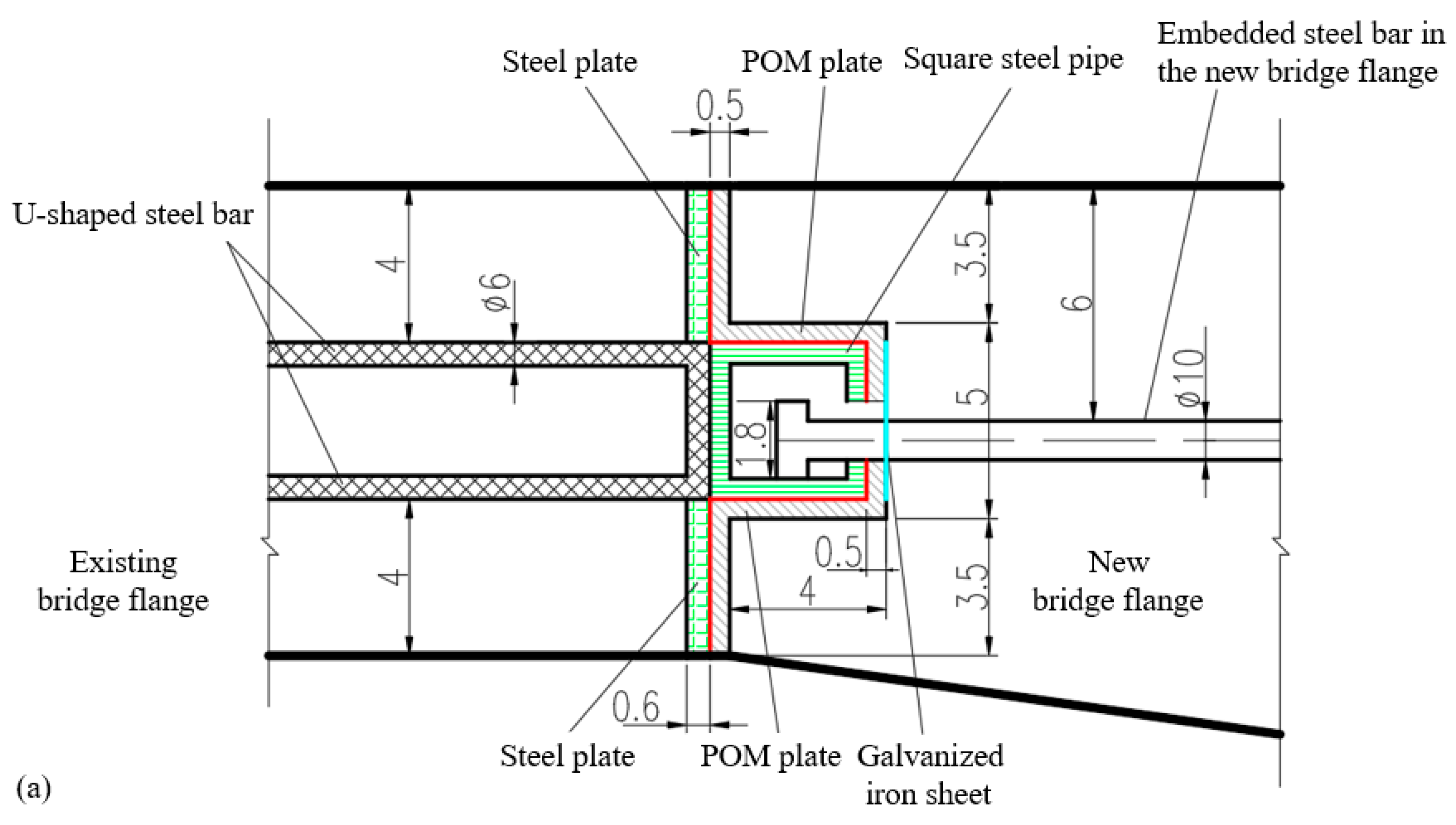
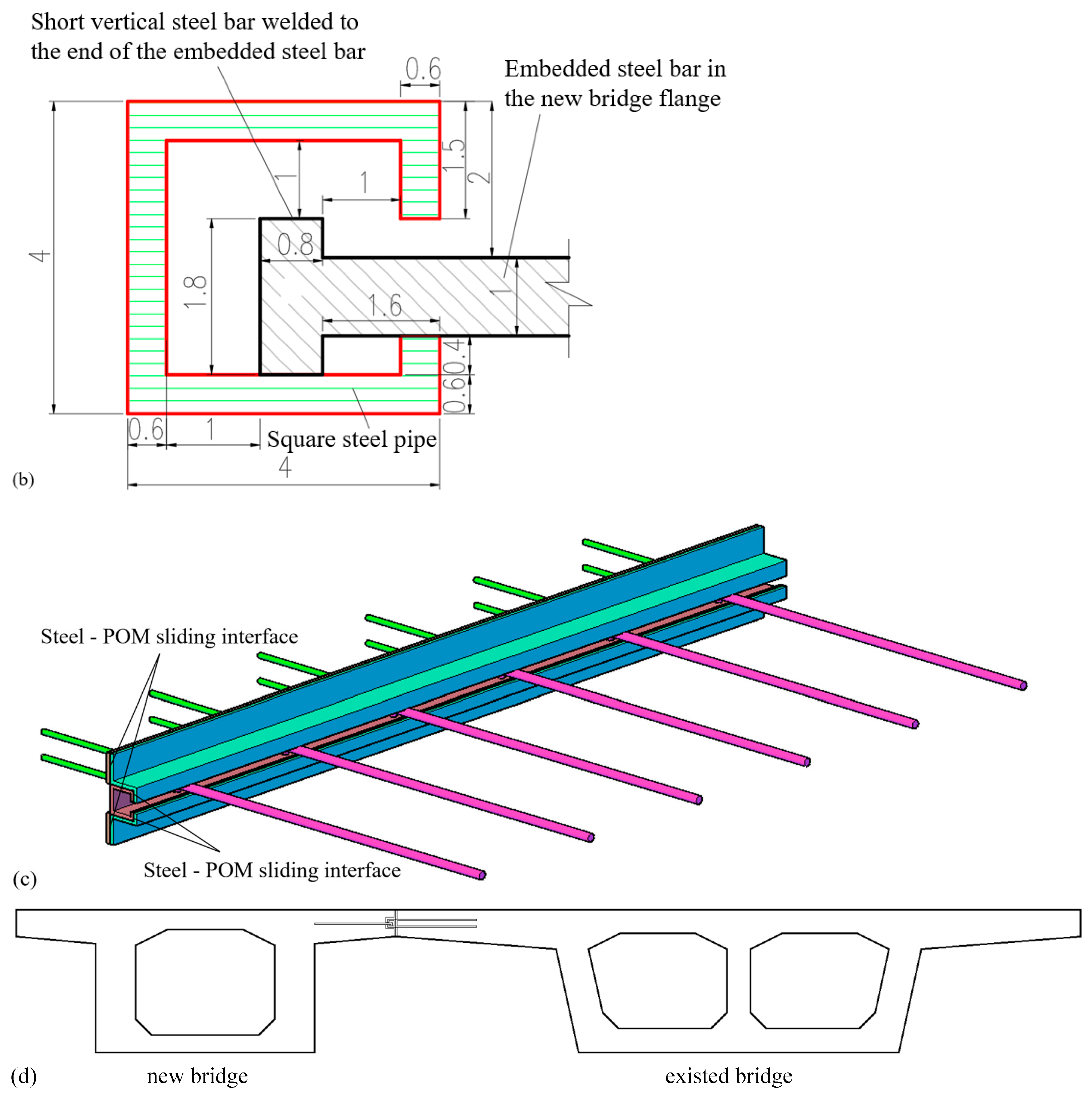
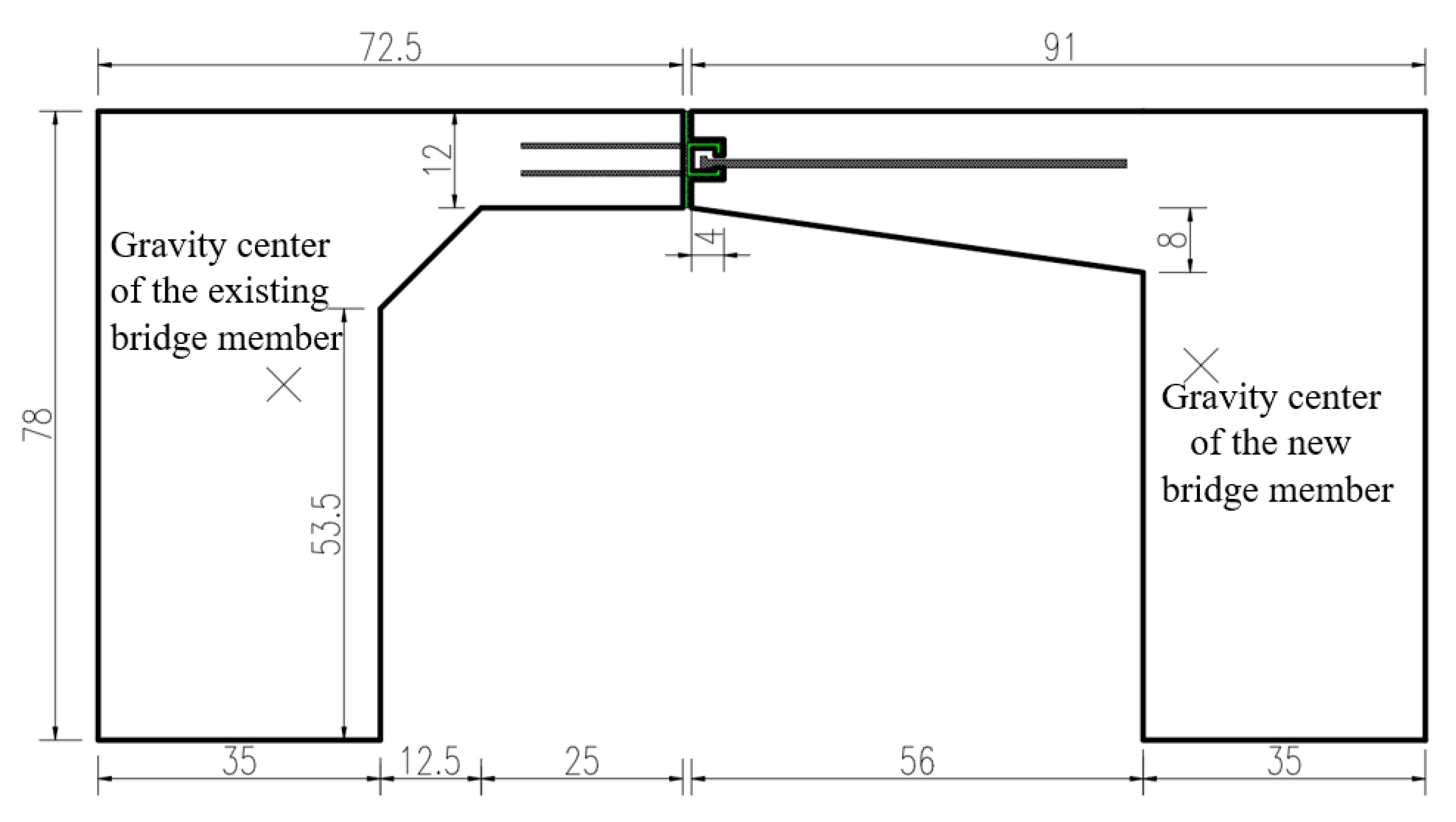
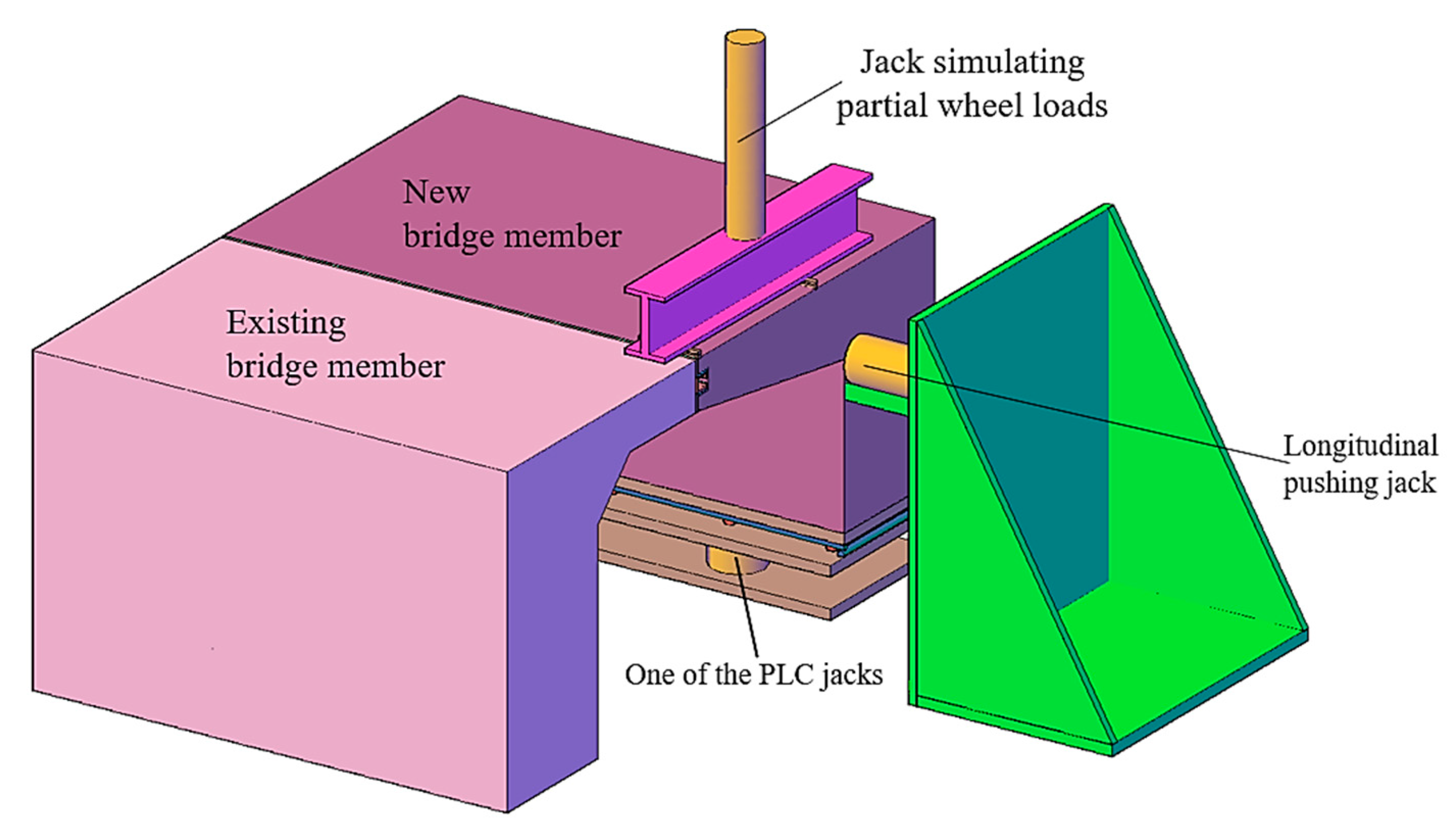
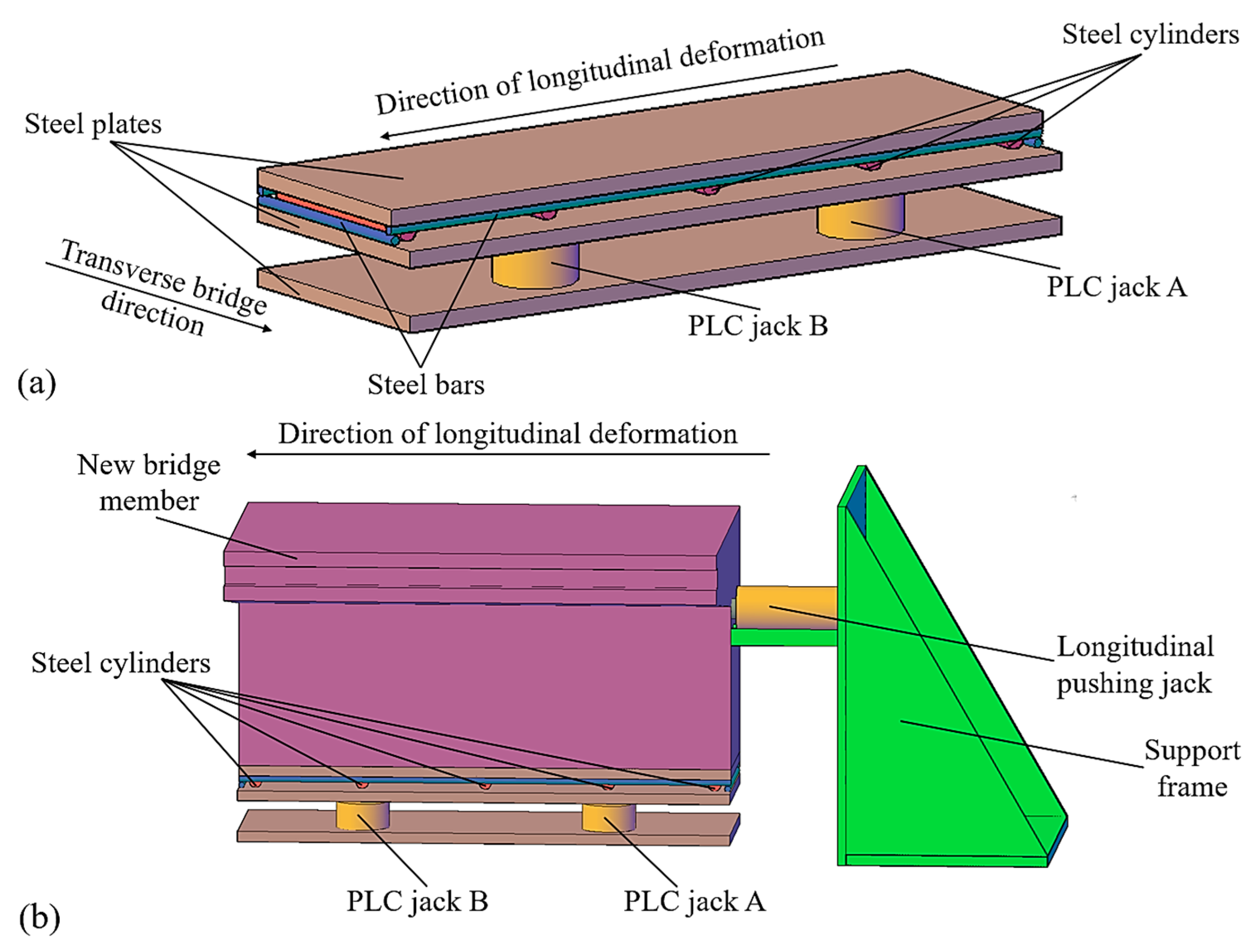

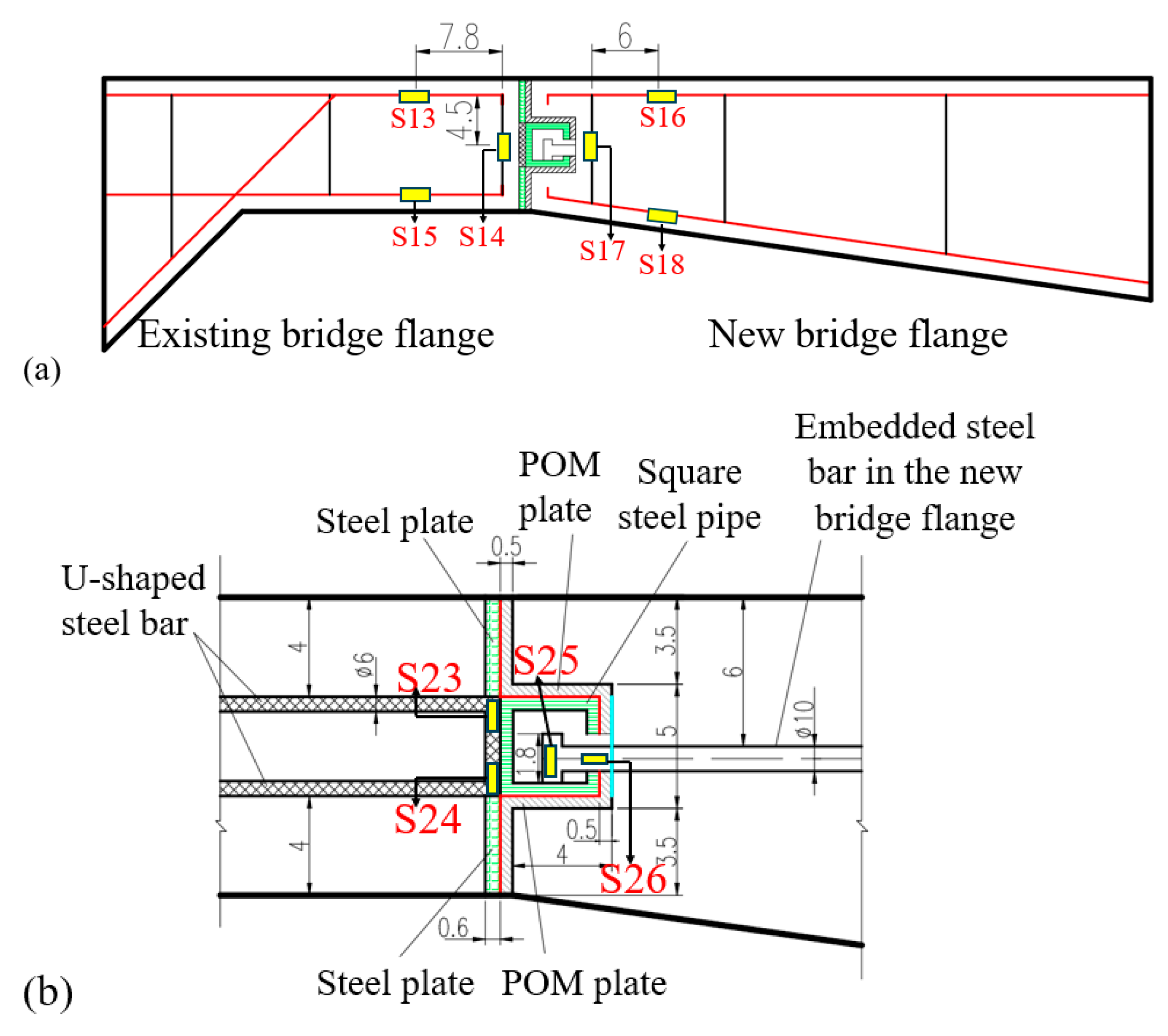



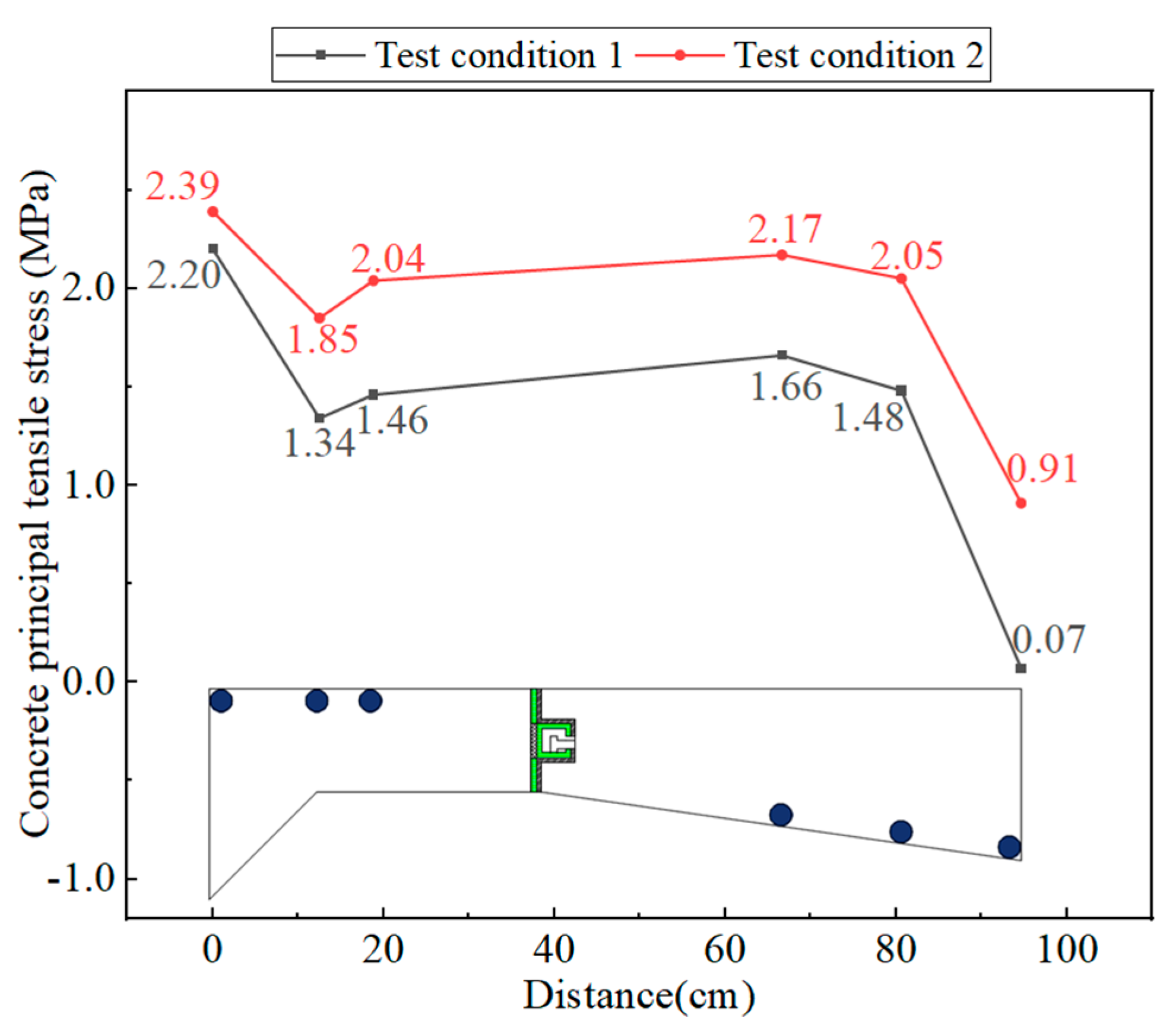

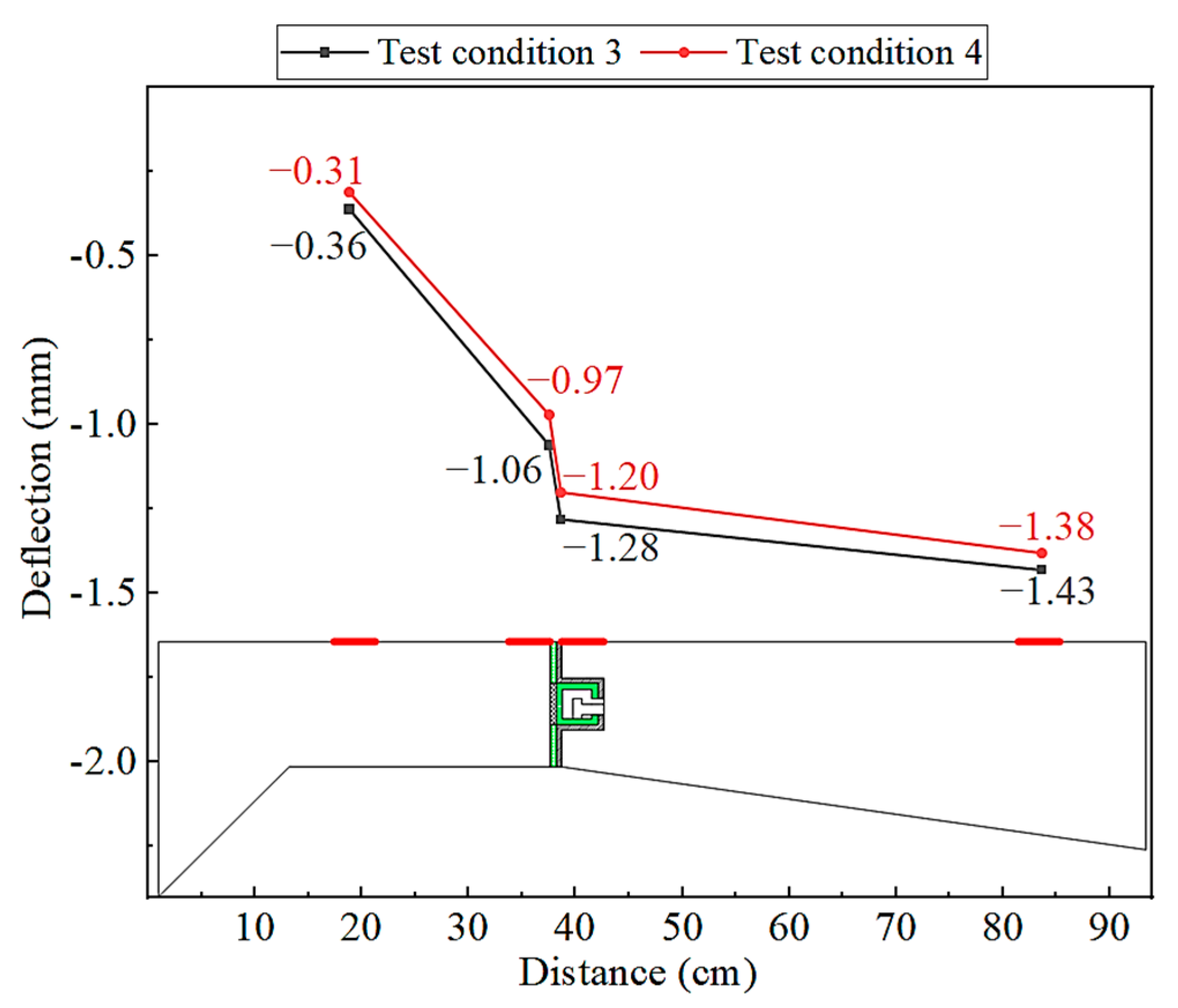

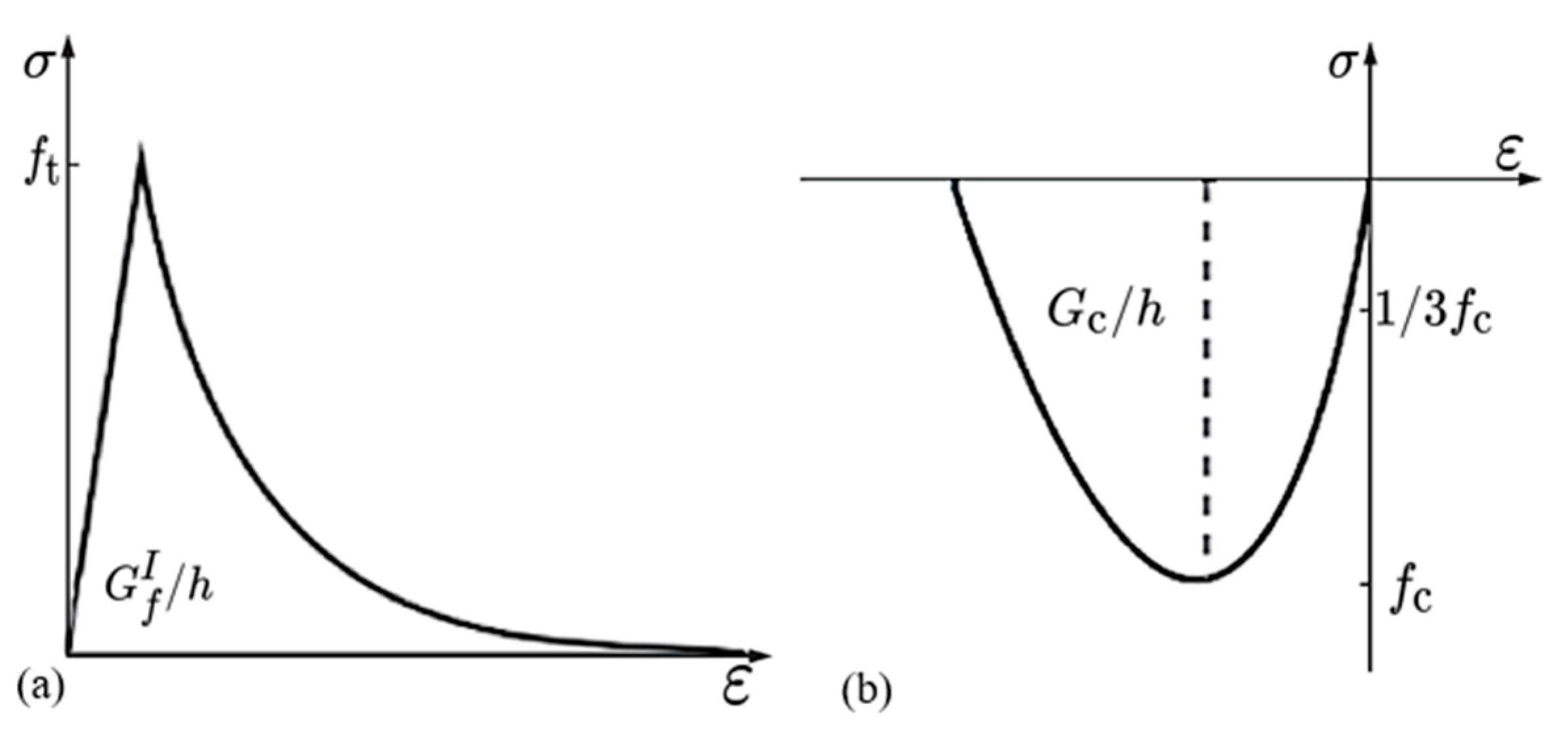
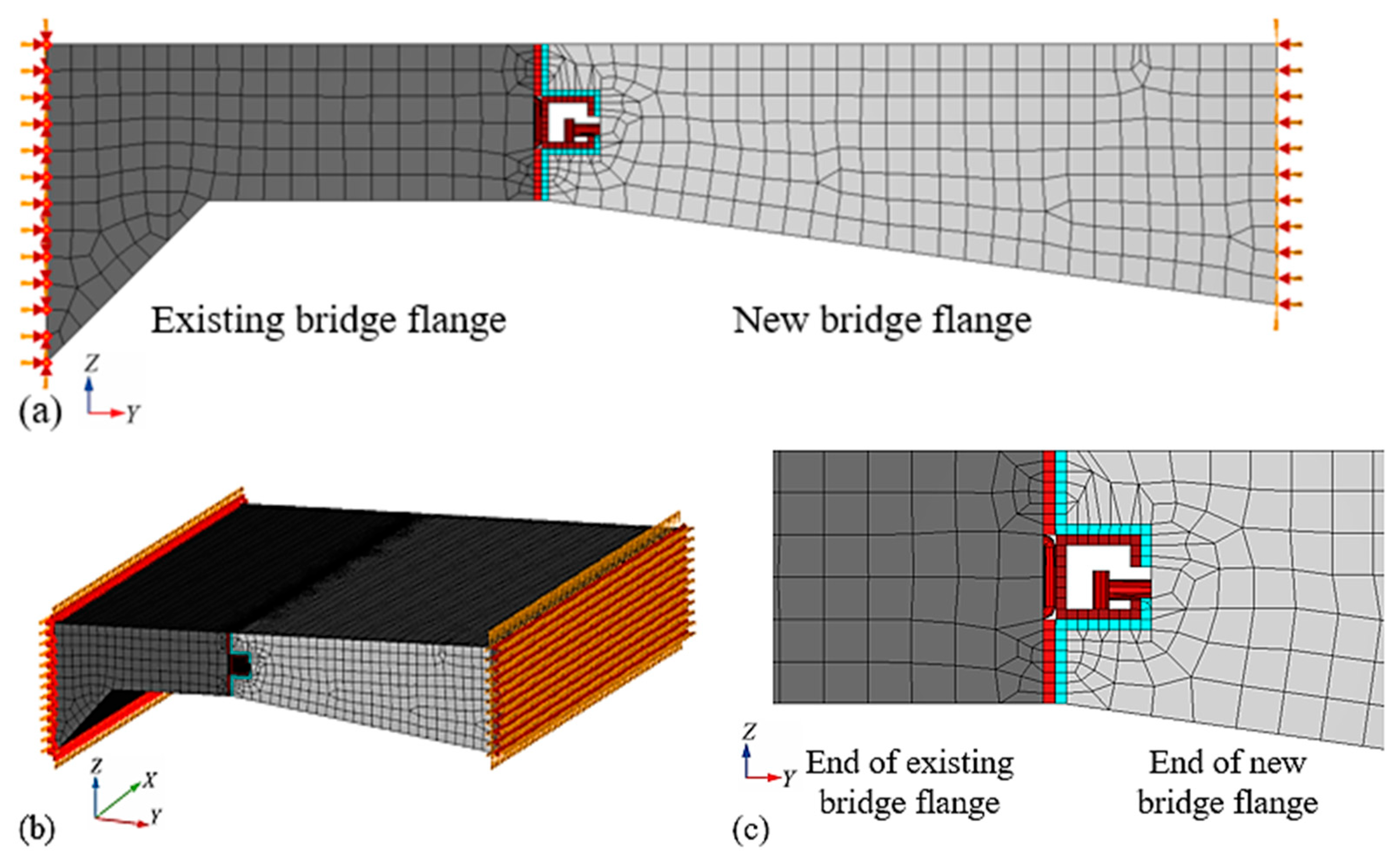
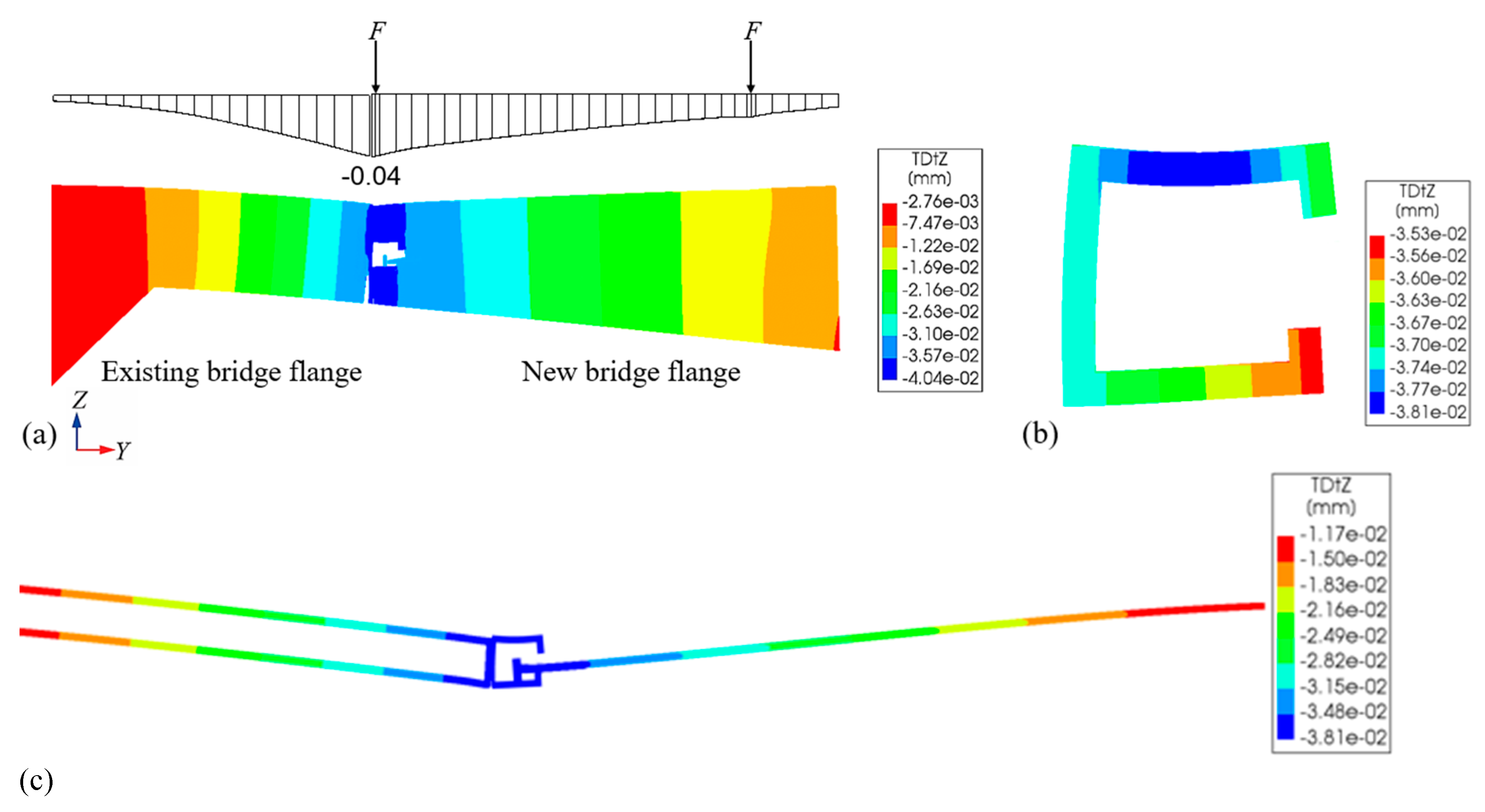
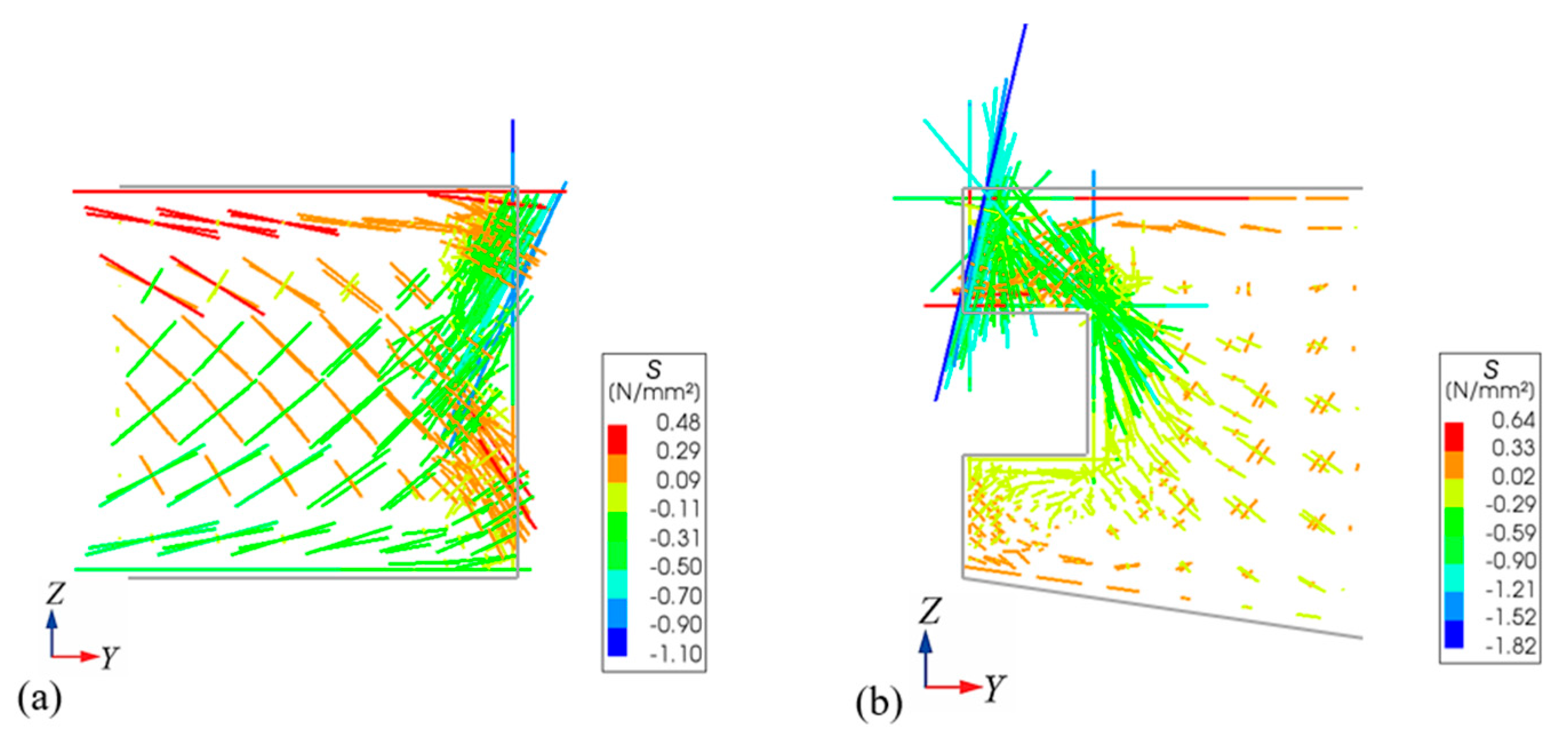

| Elastic Working Stage | Test Conditions (No.) | Wheel Loads on the Bridge Deck (Double-Point Static Load) | Uniform Settlement of New Bridge Member | Non-Uniform Settlement of New Bridge Member | Concrete Shrinkage and Creep of New Bridge Segment | |
|---|---|---|---|---|---|---|
| PLC Jack A | PLC Jack B | |||||
| Elastic working stage | 1 | + | 1 mm | - | - | - |
| 2 | + | - | 1 mm | 0 mm | - | |
| 3 | + | - | 2 mm | 1 mm | - | |
| 4 | + | - | 2 mm | 1 mm | + | |
| Materials | Modulus of Elasticity (MPa) | Density (kg/m3) | Poisson’s Ratio | Main Mechanical Parameters (MPa) | |
|---|---|---|---|---|---|
| C40 concrete | 3.25 × 104 | 2.43 × 103 | 0.2 | Tensile strength (design value) | 1.65 |
| Compressive strength (design value) | 18.4 | ||||
| HRB400 rebar | 2 × 105 | 7.85 × 103 | 0.3 | Yield strength (design value of tensile strength) | 330 |
| AISI1045 steel | 2.06 × 105 | 7.85 × 103 | 0.3 | Yield strength | 355 |
Disclaimer/Publisher’s Note: The statements, opinions and data contained in all publications are solely those of the individual author(s) and contributor(s) and not of MDPI and/or the editor(s). MDPI and/or the editor(s) disclaim responsibility for any injury to people or property resulting from any ideas, methods, instructions or products referred to in the content. |
© 2025 by the authors. Licensee MDPI, Basel, Switzerland. This article is an open access article distributed under the terms and conditions of the Creative Commons Attribution (CC BY) license (https://creativecommons.org/licenses/by/4.0/).
Share and Cite
Wu, W.; Liu, Z.; Liu, J.; Liu, D.; Chen, L.; Wang, W. Mechanism of Load Transfer and Deformation Coordination for a Novel Sliding-Type Connection Structure in Bridge Widening: Model Test and Numerical Investigations. Buildings 2025, 15, 3248. https://doi.org/10.3390/buildings15173248
Wu W, Liu Z, Liu J, Liu D, Chen L, Wang W. Mechanism of Load Transfer and Deformation Coordination for a Novel Sliding-Type Connection Structure in Bridge Widening: Model Test and Numerical Investigations. Buildings. 2025; 15(17):3248. https://doi.org/10.3390/buildings15173248
Chicago/Turabian StyleWu, Wenqing, Zheng Liu, Jiyang Liu, Dan Liu, Liang Chen, and Wenwei Wang. 2025. "Mechanism of Load Transfer and Deformation Coordination for a Novel Sliding-Type Connection Structure in Bridge Widening: Model Test and Numerical Investigations" Buildings 15, no. 17: 3248. https://doi.org/10.3390/buildings15173248
APA StyleWu, W., Liu, Z., Liu, J., Liu, D., Chen, L., & Wang, W. (2025). Mechanism of Load Transfer and Deformation Coordination for a Novel Sliding-Type Connection Structure in Bridge Widening: Model Test and Numerical Investigations. Buildings, 15(17), 3248. https://doi.org/10.3390/buildings15173248






